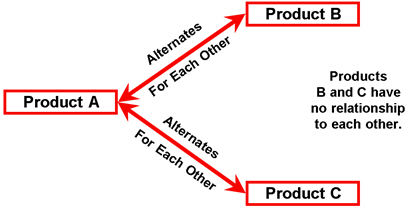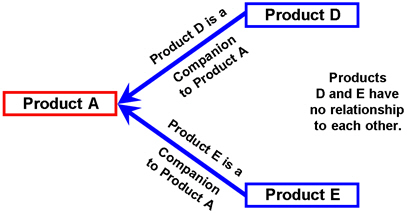
The alternate and companion products functionality gives you the means to encourage up - selling and cross - selling, helping you to maximize profits on every potential sale while enhancing the level of service you provide to your customers.
Correctly established alternate and companion product relationships can help you to make application-specific recommendations to your customers during order entry and under both the Customer Service and Retail/POS tabs.
An alternate is an equivalent product you can offer when the item your customer wants is not in stock or does not have sufficient on-hand quantity for the order. An alternate can also be a higher-end product that may be a better choice for a specific application. These are both forms of up-selling. Alternates are "in-place-of" products. For example, in automotive products, you might offer a premium oil filter instead of the standard version; in office products, you might offer a three-ring binder with D-rings instead of one with the standard round rings.
The relationship between alternate products is bidirectional (reciprocal). That is, if you set product B as an alternate for product A, product A automatically becomes an alternate for product B. Also, a product can have more than one alternate and can therefore be an alternate for more than one product. For example, in the diagram below, product A is an alternate for both B and C and vice versa. Do not become confused by the bidirectional nature of the alternate relationship: The relationship is not transitive, that is, in this example, product B is not an alternate for product C.

Set up alternates when you want to
Give your customers a range of product choices for a single application.
Reduce lost sales by having alternative products readily accessible.
Encourage sales of higher-end products.
During order entry and part search, the Vision system signals that a product has alternate products regardless of whether the alternate products are currently in stock. This gives you the opportunity to up - sell at any time.
A companion is an additional product that you can offer in order to help ensure your customer is getting everything needed for a task or project. Companions are always "in-addition-to" products. Offering companion products is a form of cross - selling.
Companion products are items that are generally bought with a certain product. For example, in the automotive market, you could offer spark plugs when your customer buys spark plug wires, or an oil filter when your customer buys engine oil. In the office products market, you could offer sheet protectors and indexes when your customer buys three-ring binders, or a chair mat when your customer buys an office chair.
The relationship between a product and its companion products is unidirectional.

Companions help create larger total ticket orders by encouraging sales people to offer products the customer may need but forgot about. Set up companions when you want to
Encourage cross-selling to increase your revenues.
Broaden your offerings to your customers.
Solidify customer relationships by offering total solutions.
During order entry and part search, the Vision system signals that a product has companion products only if the companion products are currently in stock and available for sale from the currently selected warehouse.
This ensures that you only suggest an impulse purchase when you can immediately fulfill it.
Alternates are "in-place-of" products that perform the identical function with the same form and fit. They can be either higher- or lower-priced products. Companions are "in-addition-to" products that perform a different function that may be necessary in order for the primary product to fulfill its function. Strategically setting up alternates and companions can help you increase your sales and can help you increase the overall satisfaction of your customers with potential increases in customer loyalty and repeat business.
You don't need to configure Vision to use alternates and companions. The ability to specify alternate and companion products is built into the Vision system. However, you do need to set up the alternate or companion relationships between specific products. Additionally, for companion products only, you can enable a dialog box that makes it easier to include companions on the current order.
Once you have established alternates or companions on your Vision system, Vision uses visually obvious icons to tell you that one or more alternates, companions, or both exist for the currently selected product. Vision displays the following icons on the Current Order screen <F4> and the Part screen <F5> under the Customer Service and Retail/POS tabs:
|
Icon |
Meaning |
|
|
Product has one or more alternates. |
|
|
Product has one or more companions. |
|
|
Product has one or more alternates and companions. |
The following topics provide step-by-step instructions on how to set alternates and companions for a product, how to enable the companion products dialog, and how to add alternates and companions to an order.